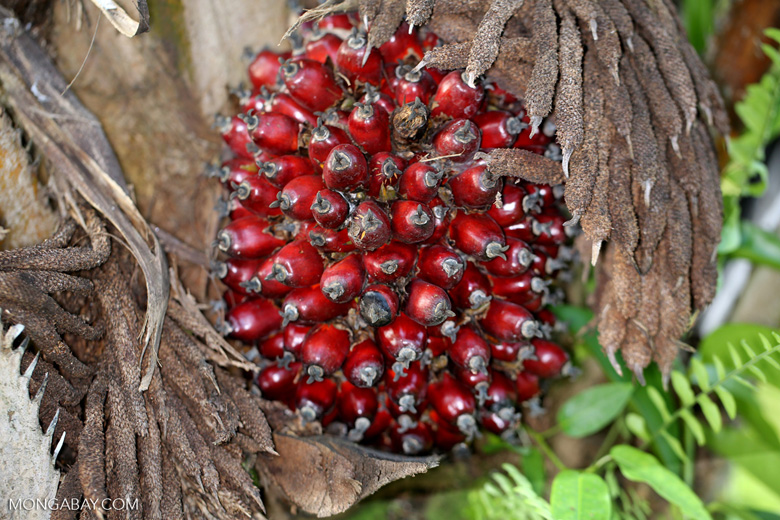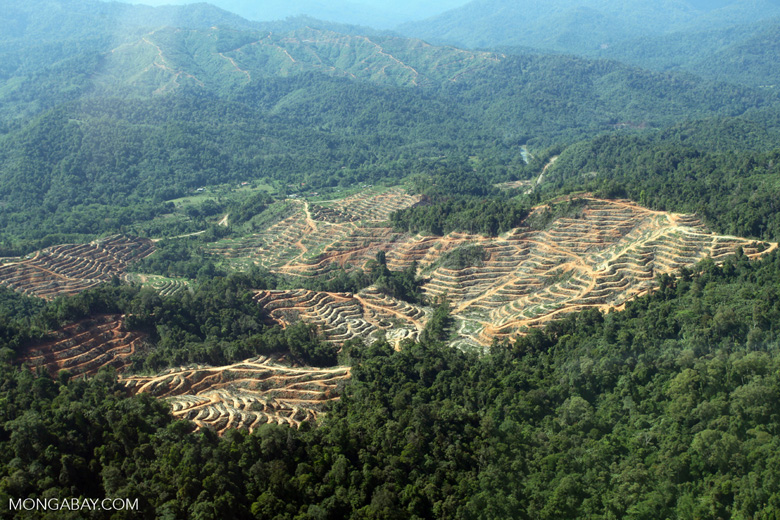- Kenya is looking to increase its own production to reduce reliance on imports. Officials say producing palm oil domestically would reduce importation costs while opening new income streams for farmers.
- Kenya is also looking to cash in on the industry’s profitability and efficiency as global demand for palm oil rises.
- But critics worry that increasing palm oil production in Kenya may come at a cost. They say smallholder farmers could lose out to industrial producers, and clearing land for oil palm plantations could increase deforestation and carbon emissions.
ISIMICHINI, Kenya — In the 10 years Arthur Inzofu has been growing oil palm trees at his farm in Isimichini village in western Kenya, he has seen few benefits. But he is not about to give up on the plant quite yet.
The 70-year-old farmer is among the few who have held onto the plant, despite what he says is years of government neglect when it comes to ensuring a ready market for the palm oil produced by oil palm growers.
However, renewed interest by the government in domestic palm oil production is giving Inzofu hope that his fortunes may turn.
Kenya is looking to increase its own production to reduce its reliance on imports. According to Kenya’s Cabinet Secretary for Agriculture, Livestock and Fisheries, Willie Bett, the country spends over Ksh 16 billion (about $1.6 million) annually on imported palm oil. Growing the plant domestically would reduce this cost while opening new income streams for farmers, officials said.
Inzofu agrees: “It can be a very lucrative crop for farmers if only we are supported with a ready market by the government,” he said, adding that a single tree gives him at least 20 clusters of fruit in a year.

A single fruit generates about a liter of processed palm oil, he said. “I have a machine which I use to process the fruits into palm oil. I use some of this at home for cooking and sell the surplus to neighbors,” he said, adding that a liter fetches about Ksh 150 ($0.15).
This is way below market price; a liter of processed palm oil sold in local supermarkets costs double the price of what he gets at home, said the father of three.
Inzofu’s concerns are echoed by hundreds of farmers who took up palm oil growing across Kenya when the government introduced the plant in 2003, according to Kenya Agricultural Research and Livestock Organization (KARLO) palm oil project leader Lusike Wasilwa.
Insufficient support
In addition to an insufficient market for his palm oil, Inzofu criticizes what he says is a lack of growing and processing support. He says that unlike other plantation crops in the region like sugarcane that have factories where farmers can take their produce for processing, Inzofu must process his harvest at home.
“The fruits are attacked by birds while a whole plant can be felled by earth moles,” he said. “It is like the government abandoned us after introducing the plant because they have never come to show us how to deal with production challenges.”

According to Wasilwa, the government did not abandon farmers outright. Rather, a lack of funding stalled the pace at which the project could proceed. She said there was also pressure from environmental groups that argued growing the plant may encroach onto land used to grow staple crops like maize, leading to food insecurity and associated deforestation.
Yet palm oil prevailed, Wasilwa contends.
“Palm oil growing in Kenya was initially meant to enable farmers to use the oil at home to boost their families’ vitamin A [intakes],” she said. “Its successful uptake means the country can grow the plant for commercial use.”
To enhance its domestic palm oil production, the Kenya government is pumping some Ksh. 87 million (about $870,000) into the sector, Wasilwa said.
New seed varieties that produce a shorter plant, mature earlier and yield more fruit are being acquired from India, according to Cabinet Secretary Bett.
“Our intention is to increase the productivity of palm oil in Kenya so that our manufacturing industry can grow,” Bett said in an interview with Mongabay. “Revitalizing its production in Kenya means that we will build factories to do value addition locally.”
In addition to a desire to get away from reliance on palm oil imports, Kenya is also looking to cash in on the industry’s profitability and efficiency. Palm oil is one of the most ubiquitous vegetable oils in the world, and is found in a multitude of products from cooking fat and cookies to soaps and cosmetics. Research conducted in 2016 indicates the global demand for palm oil has been rising since the 1970s, making it worth some $50 billion a year, a number that’s projected to rise to $88 billion by 2022.

The oil palm tree also yields more oil per hectare cultivated compared to other vegetable oils like sunflower or soy. According to KARLO, an oil palm plantation can yield more than 10 metric tons of fruit per hectare every year. In comparison, Kenya’s leading cash crops like tea and coffee yield less than eight metric tons for the same area.
Smallholder concerns
However, not everyone is convinced Kenya should embrace industrial palm oil production.
Kazungu Jumwa, a farmer who has been growing oil palm in Kenya’s coastal region for the past five years fears that growing the plant for industrial extraction may put smallholders like him out of business.
The sturdy plants at his four-acre farm in Matuga village have been the main source of income for his family. Jumwa said he feeds and pays school fees for his children by harvesting the fruit and selling it to processors in the coastal town of Mombasa.
Jumwa has tried growing staple crops like corn. But repeated drought that has been troubling the country often leaves him with little to harvest, he said, adding that he prefers the oil palm tree because it can withstand harsh weather.
“I fear that if the government allows multinationals to grow palm oil in Kenya, I may lose the market that I currently rely on,” he said adding that the government is not clear on how it will protect smallholders from big investors.
Bett, the Agriculture Cabinet Secretary, said Kenya does aim to scale up oil palm cultivation in the country through industrial production.
But he said smallholder farmers will not be affected because they will be issued contracts to supply their harvest to processing factories that the government will establish.
Moreover, oil palm cultivation could be an alternative crop choice in areas that experience repeated pest attacks and drought, said Nesline Ogwe, manager of the lower Kuja irrigation project in the Lake Victoria region.
In January of this year, the region’s corn crop was hit by a devastating Fall Army Worm invasion. A few months prior, a lethal corn necrosis disease also swept the region, she said.
“For the past two seasons [corn] farmers have been harvesting little due to frequent pest attacks,” Ogwe said. “It is time they started diversifying to other crops.”
She said the irrigation project is keen to support oil palm cultivation because it will enable farmers to diversify their crops.
The 19,000-acre project has already conducted a feasibility study on large-scale oil palm cultivation, Ogwe said. She expects that cultivation will take off immediately after infrastructure is in place.
“We will help farmers do land preparation, identify investors and markets for palm oil,” she said. “We will then get for them the seeds and all the inputs needed to grow the plant.”
Ogwe said oil palm cultivation will be a new but more secure venture for farmers in the region: “complete crop failure can happen with rice, maize, and other field crops when moderate to extreme drought or flood occurs, but not with palm oil.”
However, not all agree. Clive Davis, fund manager at Kenya’s Business Advocacy Fund, questions why the government is introducing large-scale cultivation before establishing markets. He said the government should leave it to the private sector.
“This is probably a scam in waiting that will put a lot of burden on the taxpayer,” Davis said. The Business Advocacy Fund lobbies the government to create an attractive environment for private sector investment.
Environmental cost
Then there’s the environmental side of the issue. Some critics say Kenya has neither the right geography nor climate for palm oil production; others worry it could put the country’s forests at risk.
Frank Msafiri, chairman of the Kenya Climate Change Working Group (KCCWG), is concerned the country’s plan for large-scale oil palm cultivation may lead to deforestation. He said huge tracts of land will be required for the plantations, which can only accommodate 143 plants per hectare. In comparison, he said a farmer can grow about 75,000 corn plants on one hectare.
This concern is shared by conservationists and scientists who worry about the negative impacts the palm oil industry has had on the forests of major production countries – namely Indonesia and Malaysia – spreading as the industry expands to other tropical countries. A 2016 study published in the journal Conservation Letters found that if governments of African countries fail to enact policies regulating forest clearance and promoting preservation, many forests stand to be converted to huge oil palm plantations. This deforestation, researchers say, could release massive amounts of carbon into the atmosphere and contribute to global warming.

However, agriculture consultant George Mbakaya said oil palm plantations can also act as carbon sinks because they are heavy consumers of carbon dioxide. He added that palm oil may also help reduce Kenya’s use of emissions-heavy fossil fuels.
“Palm oil byproducts can be used to generate biofuel, biogas and electricity, enabling Kenya to reduce its dependence on fossil fuels,” Mbakaya said.
Proponents expect palm oil will yield industrial benefits as well as more reliable income smallholders. But not everyone thinks palm oil will pick up.
Isaac Morang’a, an agronomist practicing in Western Kenya, said farmers are used to crops like corn that they can harvest from the farm and consume or sell directly. He said that for palm oil, few farmers have the technology at the farm level to process the fruit into oil before consuming at home or selling it.
“It will take a long time before Kenyan farmers begin to see returns from palm oil growing,” Morang’a said.
FEEDBACK: Use this form to send a message to the editor of this post. If you want to post a public comment, you can do that at the bottom of the page.







